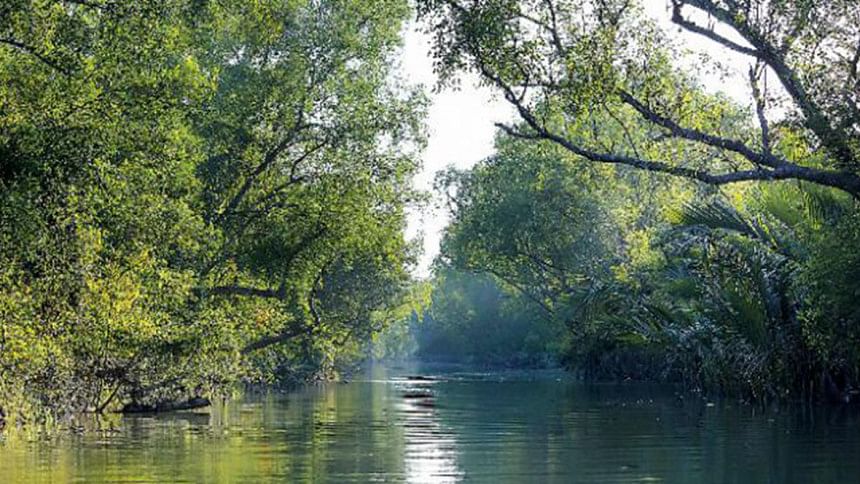Sundarbans wildlife gets extended sanctuary

The biodiversity boundary has been extended in the Sundarbans, the world's largest mangrove forest. Experts expect the move to help boost all types of forest resources including wildlife, fisheries, and trees.
The government imposes a ban on collection of all types of wild resources from areas designated as 'sanctuaries' in the forest. The Forest Department has demarcated these sanctuary areas by colouring the trees differently in those areas and blocking the entrance of fishermen, Bawals, and Mowals.
The Sundarbans is the world's largest coastal mangrove forest, straddling the border of India and Bangladesh. The total area of the Sundarbans is 6,017 sqkm.
According to a new notification issued by the government, over half the Sundarbans' total area falling within Bangladesh is now designated as sanctuary, which will go a long way towards the protection of wildlife in the mangrove forest.
The 'sanctuary' designated areas now add up to 317,950 hectares, over double the 139,699 hectares that was categorised as such over two decades back.
In 1996, the government granted a 139,699-hectare area of the forest sanctuary status, covering 23 percent of the total area of the forest.
Recently, the government issued a new notification on the expansion of sanctuary areas in different parts of Sundarbans after 21 years. Through this notification, another 178,260 hectares have been added to the existing sanctuary aggregate. That means over half the area of the Sundarbans in Bangladesh has sanctuary status.
Forest Department sources said of the additional 178,000-odd hectares falling under sanctuary, 91,693 hectares has been added in Sundarbans East under the Sarankhola range; 38,339 hectares in the Sundarbans South under the Khulna range and a total 48,216 hectares area has been added in Sundarbans West, under the Satkhira range.
Md Amir Hossain, forest conservator of Khulna circle, said the government has banned the collection of all types of forest resources from the sanctuary areas. It will help increase the biodiversity of the forest including wildlife and trees.
The birth rate of wild animals ranging from the tiger to the deer and all the birds and fish will increase in the safe sanctuary, Amir Hossain predicted.
Md Mahmudul Hasan, divisional forest officer of Sundarban East, said the Forest Department has marked the sanctuary areas of the Sundarbans. Placards and signboards would be hanged at different points within two months. None can enter the sanctuary areas for any forest resource collection, he emphasised.
Even the fishermen, Bawals and Mowals are confined to a mere 12,000 who are allowed to enter the forest for extracting resources under strict monitoring.
Meanwhile, a project titled 'Sundarbans Protection' has been proposed that awaits approval of the Executive Committee of the National Economic Council (ECNEC). This project will help to engage people near the forest in alternative employment that is not dependent on the depletion of the forest's resources, he informed.
Professor Dr. Mahmud Hossain, at the Forestry and Wood Technology department of Khulna University, said the expansion of sanctuary is good news for the Sundarbans as it will reduce "human pressure on the forest."
An end to the extraction of its resources is expected to precipitate a boon to the population of wildlife, trees and water resources will increase in the Sundarbans. The government will be faced with the challenge to conjure up alternative employment for the people who are dependent on the forest resources.
On the other side of the coin, the forest-dependent traders, fishermen, Bawals and Mowals are not pleased one bit by the expansion of area under sanctuary have been facing extreme poverty, since the expansion of the sanctuary area in Sundarbans.
Jalal Mollah, a fishing trader of Sarankhola upazila, said he has no business due to the expansion of the sanctuary area in the Sundarbans. He and his boatload of fishermen with their nets could catch nothing, no netting fish as most of the rivers in the upazila are under sanctuary.
A good number of fishermen have become jobless and now they are searching for alternative employment, he added.
Alamin Munshi of Khurialkhali village and Phul Mia of Sarankhola village, relayed how they've been faced with extreme difficulty in running their families as the expansion of the sanctuary in Sundarbans and ban on fishing in the sanctuary areas rendered them and their fishing boats more or less useless.
Their grievance, quite clearly, was not so much at the vast new chunks of forest being closed off to them, but rather that it was done without providing any alternative employment, a means to live, for the fishermen and others like them, who depend on its resources.

 For all latest news, follow The Daily Star's Google News channel.
For all latest news, follow The Daily Star's Google News channel. 







Comments